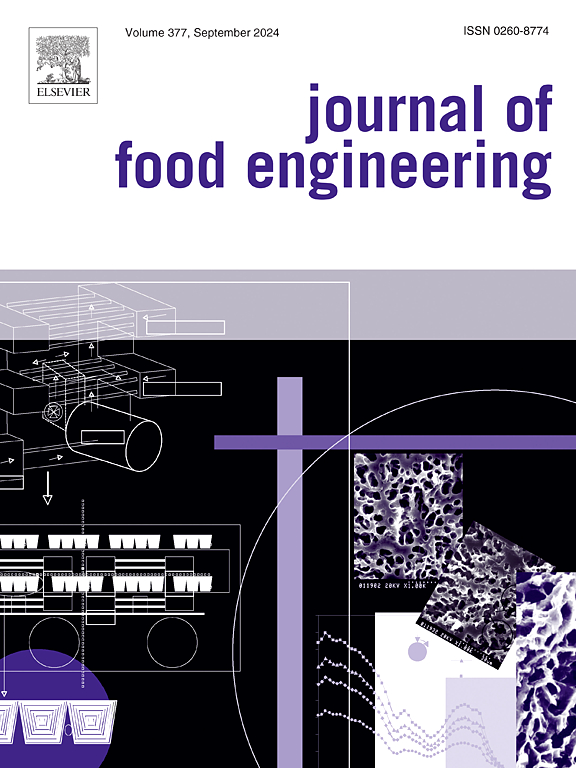脉冲欧姆加热对牛奶中食源性病原体的细菌灭活和杀菌机制取决于应用频率
IF 5.8
2区 农林科学
Q1 ENGINEERING, CHEMICAL
引用次数: 0
摘要
关于频率与欧姆加热(OH)中微生物失活之间的关系是直接的还是相反的,已经报道了相互矛盾的结果。本研究的主要目的是探讨脉冲欧姆加热(POH)在不同频率下对细菌的灭活和杀菌机理。用食源性致病菌接种的牛奶样品在恒定电压为70 Vrms、施加频率为0.06、0.1、1或10 kHz的条件下进行POH。使用POH将样品加热到60°C,并在该温度下保持10分钟。0.06 kHz时POH的细菌灭活水平显著更高(P <;0.05)比0.1-10 kHz的频率高。例如,在0.06 kHz时,鼠伤寒沙门氏菌比在0.1-10 kHz时减少了2 log CFU/ml以上。采用双-(1,3-二丁基巴比妥酸)三甲氧基醇(DiBAC4(3))分析,0.06 kHz POH后细胞膜去极化程度显著高于其他频率。反映细胞通透性的结晶紫吸收值在0.06 kHz时也最高。由于0.06 kHz的POH对细胞膜造成了致命的破坏,增加了细胞膜的通透性,细胞内物质的泄漏量最大。通过DNA完整性评估,0.06 kHz的POH对所有病原体都造成了严重的DNA损伤。据推测,出现这些结果是因为0.06 kHz的POH为细胞膜和DNA周围的电荷积累提供了足够的时间。本研究为确定低频POH导致细菌高失活的机制提供了基础的科学依据。本文章由计算机程序翻译,如有差异,请以英文原文为准。
Bacterial inactivation and bactericidal mechanisms of pulsed ohmic heating against foodborne pathogens in milk depending on the applied frequency
Conflicting results have been reported regarding whether the relationship between frequency and microbial inactivation in ohmic heating (OH) is direct or inverse. The main purpose of this study was to investigate the bacterial inactivation and bactericidal mechanism of pulsed ohmic heating (POH) depending on the applied frequency. Milk samples inoculated with foodborne pathogens were subjected to POH at a constant voltage of 70 Vrms with applied frequencies of 0.06, 0.1, 1, or 10 kHz. The samples were heated to 60°C using POH and held at that temperature for up to 10 min. The bacterial inactivation levels of POH at 0.06 kHz were significantly greater (P < 0.05) than those at 0.1–10 kHz. At 0.06 kHz, for instance, Salmonella Typhimurium reduced more than 2 log CFU/ml compared with that at 0.1–10 kHz. Cell membrane depolarization, analyzed using bis-(1,3-dibutylbarbituric acid)trimethine oxonol (DiBAC4(3)), was significantly greater after POH at 0.06 kHz compared to other frequencies. The value of crystal violet uptake, which reflects cell permeability, was also highest at 0.06 kHz. Because POH at 0.06 kHz fatally damaged cell membranes and increased permeability, the largest amount of intracellular material leaked. Through a DNA integrity assessment, POH at 0.06 kHz provoked severe DNA damage to all the pathogens. It was speculated that these results occurred because POH at 0.06 kHz provided enough time for the buildup of charges around the cell membranes and DNA. This research provides a fundamental scientific basis for determining the mechanism by which low-frequency POH results in high bacterial inactivation.
求助全文
通过发布文献求助,成功后即可免费获取论文全文。
去求助
来源期刊

Journal of Food Engineering
工程技术-工程:化工
CiteScore
11.80
自引率
5.50%
发文量
275
审稿时长
24 days
期刊介绍:
The journal publishes original research and review papers on any subject at the interface between food and engineering, particularly those of relevance to industry, including:
Engineering properties of foods, food physics and physical chemistry; processing, measurement, control, packaging, storage and distribution; engineering aspects of the design and production of novel foods and of food service and catering; design and operation of food processes, plant and equipment; economics of food engineering, including the economics of alternative processes.
Accounts of food engineering achievements are of particular value.
 求助内容:
求助内容: 应助结果提醒方式:
应助结果提醒方式:


